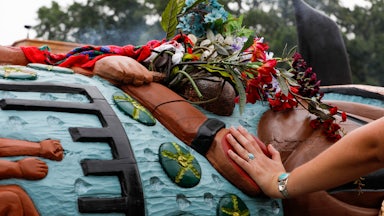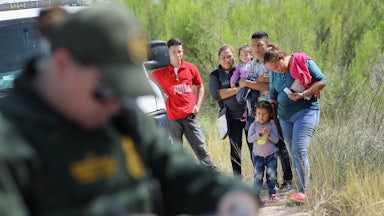In September 2020, border wall construction was closing in on a rare desert spring in southern Arizona. Officially sitting on Organ Pipe Cactus National Monument land, the Quitobaquito Springs have long been a sacred site for Tohono O’odham and Hia Ced O’odham people. In an explosive frenzy of construction leading up to the 2020 elections, Trump’s wall, bollard by bollard, was being erected closer and closer to the springs, threatening water levels, wildlife, and traditional O’odham spiritual and cultural practices.
Amber Ortega, who is Hia Ced O’odham, felt “a spiritual call” to be at the springs as much as she could to protect the sacred ground. On September 9 of last year, as she was praying and honoring her ancestors, she heard the rumble of heavy machinery. An earth mover was driving in, resuming construction on the border wall. Ortega and another member of the Hia Ced O’odham, Nellie Jo David, planted themselves in front of the machines and began singing. David sat herself in the bucket of one of the vehicles. After a prolonged standoff with construction crews, Border Patrol agents and national park rangers were called in. The rangers arrested both women for trespassing on their own ancestral land.
David accepted a plea deal earlier this summer (only after her life had been made a “living hell” by the government, as she put it to us), but Ortega’s trial is ongoing, with federal prosecutors doggedly pursuing two misdemeanor charges and arguing in court that she should not be able to use a religious defense of her actions. While the arrests occurred during the Trump administration, the very decision to proceed with the case reflects how the Biden administration, despite professing to turn the page on Trump-era anti-immigration and anti-Indigenous policies, is still upholding the legacy of trampling on Indigenous land and rights. The case also highlights the unresolved impact of Trump’s border wall construction push: Biden pledged to stop it; Arizona and Texas have sued for it to continue; and the pernicious effects of the currently existing wall persist, despite remediation efforts in a few places.
On November 4, a judge heard arguments in court in Tucson as to whether 35-year-old Ortega had violated a closure order for a road along the U.S.-Mexican border and failed to heed a directive from a government agent. If she’s found guilty, she could be jailed for up to six months, in a case that raises profound questions about religious freedom and the ongoing legacy of colonial dispossession and anti-Indigenous violence.
On the witness stand,
Ortega explained the significance of the border wall and the destruction it has
wrought. “It felt like a complete disrespect to our culture,” she said. “It
felt violent. It felt degrading. It felt like a continuation of the violence
done to our people, without regard to who we are or what we believe in.”
Immigration enforcement—especially the invasive presence of Border Patrol and the construction of the border wall—has long caused havoc on Indigenous lands along the U.S.-Mexican border. David, Ortega’s former co-defendant, put it bluntly: “We live in war. If we’re stopped out there on the reservation or in and around Ajo”—a small town in southern Arizona—“how many Border Patrol will show up? They treat it like it’s a war scenario.”
Though they are habituated to dealing with harassment from the federal government, Trump’s desperate push to extend the border wall was a dire threat for borderlands residents, especially Tohono O’odham and Hia Ced O’odham peoples, whose lands extend to the north and south of the current international divide. The Quitobaquito Springs hold critical spiritual and environmental importance to the O’odham people “since time immemorial,” as Ortega put it at the hearing. That dates back at least 16,000 years, which is as long as people have inhabited the area and relied on the springs. As recently as the 1980s, there was a village at the spring. There remains a burial ground, and O’odham residents from both sides of the border come to hold ceremonies, though during periods of wall construction or maintenance they have to apply to the National Park Service for permits.
Lorraine Marcus Eiler, an expert witness at the hearing, tried to capture the importance of the location. She is a civic and environmental leader of the Tohono O’odham Nation and currently serves as a member of the legislative council. “It’s difficult to explain because people on the outside think you could only pray in a church,” Eiler said. “The people I come from do their ceremonies around their communities, in Quitobaquito, in the Pinacates [mountains in the northern Mexican state of Sonora]. It’s our church. The whole area is our church. We don’t need a building or a structure over us.”
In recent years, hundreds of miles of new roads have been cut into the desert. The wall itself, as it is raised along ever more stretches of the border, blocks and diverts migratory patterns not only for humans but also for critically endangered animals, including jaguars, Mexican wolves, black bears, and pronghorn antelope. Besides the wall and the roads, hundreds of miles of lighting confounds birds, insects, and other animals. Perhaps most alarming is the heavy water usage, with wells dug to mix vast quantities of cement, leading to the depletion of aquifers and rare desert springs. In eastern Arizona, wells created specifically for border wall construction were sucking up over 700,000 gallons of water a day, according to Myles Traphagen, borderlands program coordinator for the Wildlands Network. Those millions of gallons were coming directly from an aquifer that is rarely replenished and is a source of “fossil water,” which slowly filters through volcanic rock and last saw the light of day as long as 10,000 or more years ago.
The Quitobaquito Springs have also been diminishing because of drilling and water usage. Shortly before Ortega and David’s arrest, National Geographic reported that the flow of water into the springs had dropped by 30 percent. It was the lowest the water had been in decades. “Mud turtles and pup fish,” Eiler said at the trial, referencing two critically endangered species, “were just struggling.” Ortega observed the same: “The damage was visible.”
Quitobaquito also remains an important transit site. Various O’odham people live on both sides of the border and have long used the springs as a stopping point on their way south to the Gulf of California or north to mountains in present-day Arizona. Traditional salt runners—O’odham people who travel to collect and trade salt—still stop at Quitobaquito to recharge, though now their circuit will have to include navigating around the border wall.
Ortega’s defense wrapped these environmental and cultural concerns into her claim that she was acting on a sincerely held religious belief. As David told us, days before Ortega’s hearing, the environmental and the spiritual concerns are one and the same for O’odham people. “It is not separate at all,” David said. “If we’re including our spirituality, we’re taking into consideration these turtles, the pronghorn, the jaguar, the owls, all of these animals that are affected by the border wall. We hold all of these animals as sacred. So destroying the ecosystem, that’s part of the hurt. That’s part of what our spirituality is: preserving creation, preserving everything that’s on the land and also making sure things are sustainable for future generations.” Asked if there was religious significance of Quitobaquito at the hearing, Ortega responded: “It’s beyond that. It’s part of the survival of my people. It’s why we are still here.”
The U.S. government, meanwhile, is trying to block Ortega from using her religious defense, which she is claiming under the Religious Freedom Restoration Act, a federal law passed in 1993 that recognizes all religions and stops the government from infringing upon a person’s religious practices. And yet Assistant U.S. Attorney Vincent Sottosanti said at the hearing, “Whether the defendant has a religious objection is irrelevant.”
Sottosanti referenced a 2008 Ninth Circuit Court of Appeals ruling that allowed local officials in northern Arizona to spray water containing trace amounts of human waste on a mountain considered sacred to the Navajo and other Indigenous peoples; the intent was to use the treated wastewater to make artificial snow for a ski resort. The Navajo Nation objected and sued, but the Ninth Circuit ruled in favor of city officials, and the Supreme Court declined to hear the case, upholding the lower court’s decision. Citing that case, Sottosanti said that the government “can do whatever we want with our own land. The government can even destroy the land completely.” Sottosanti was admitting the stance the federal government has long taken toward Indigenous land: ruthlessly expropriating and, if necessary, destroying it for its own gain.
When Ortega and David blocked the construction vehicles, Border Patrol agents were the first law enforcement officers to respond and order the women off the land. “I didn’t feel like I could leave,” Ortega told the court. “I didn’t feel safe. I wanted their machines and their guns to leave.” Ortega continued singing, stopping to explain to the agents and rangers who she was and why she was there. She then asked them to leave.
Instead, Ortega and David were arrested, held incommunicado for hours, and taken to an immigration detention center hours away, where they remained in shackles and say they were subjected to multiple strip searches, deloused, yelled at, and not given a bed or access to a phone until the next morning. After being charged, they were placed in pretrial services and forced to check in regularly and give video tours of their homes. They were not allowed to leave the state or the country and were forced to submit to frequent urine samples. David told us this didn’t exactly feel unexpected: As O’odham, she said, “we are used to having constant surveillance. We are used to being monitored heavily, and it’s affected our entire lives.”
Ortega’s day in court ended without resolution. The judge will issue a written ruling, but the timing of that is unclear. At stake is whether Ortega can claim the Religious Freedom Restoration Act in her defense and whether the government can maintain that she trespassed on land that had long been inhabited and cared for by her ancestors.
After the hearing, Ortega had to go directly to pretrial services, where she was reminded that she is still charged with two misdemeanors and still subject to the government’s control. With a group of supporters cheering as she finally exited the courtroom, she said that she had hoped to be free. But “my body feels like it’s owned by the federal government,” she added.
In the courtroom, though, Ortega remained defiant. When the Assistant U.S. Attorney was cross-examining her, he asked: “You’re aware that that was federal land?” Ortega responded: “It will always be Hia Ced O’odham land.”










